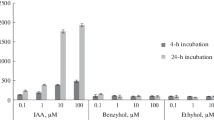Summary
Plants are settled by epiphytic bacteriae able to convert tryptophan to IAA. This bacterial activity is abolished by chloramphenicol and streptomycin but not by penicillin. Tryptophan conversion to IAA by plant parts or enzyme preparations is far more intensive in non-sterile conditions than in sterile ones. This is true for all investigated objects: Helianthus annuus, Phaseolus vulgaris, Pisum sativum, Triticum vulgare, Zea mays, Enteromorpha compressa, Fucus vesiculosus, Furcellaria fastigiata. From pea plants, 58 strains of IAA producing bacteriae were isolated and partly identified.
While non-sterile plants (Pisum, Zea) contain considerable amounts of IAA (extraction, thin layer chromatography, biotest), hardly any traceable auxin can be extracted of sterile plants. But sterile plants re-infected with mixtures or single strains of suitable bacteriae again contain considerable amounts of extractable IAA.
Zusammenfassung
Pflanzen sind von epiphytischen Bakterien besiedelt, die Tryptophan zu IES umsetzen können. Diese bakterielle Aktivität wird unterbunden durch Chloramphenicol und Streptomycin, aber nicht durch Penicillin. Der Tryptophanumsatz zu IES durch Pflanzenteile oder Enzympräparate ist unter unsterilen Bedingungen weit intensiver als unter sterilen. Das trifft für alle untersuchten Objekte zu: Helianthus annuus, Phaseolus vulgaris, Pisum sativum, Triticum vulgare, Zea mays, Enteromorpha compressa, Fucus vesiculosus, Furcellaria fastigiata. Von Erbsenpflanzen konnten 58 Stämme IES-produzierender Bakterien isoliert und zum Teil identifiziert werden.
Während unsterile Pflanzen (Pisum, Zea) beträchtliche IES-Mengen enthalten (Extraktion, Dünnschichtchromatographie, Biotest), kann aus sterilen Pflanzen kaum nachweisbares Auxin extrahiert werden. Aber sterile, mit Mischungen oder einzelnen Stämmen geeigneter Bakterien re-infizierte Pflanzen enthalten wieder beträchtliche Menge extrahierbarer IES.
Similar content being viewed by others
Literature
Ballin, G.: Dünnschichtchromatographische Trennung von Indolderivaten in neutralen Fließmitteln. J. Chromatogr. 16, 152 (1964).
Kaper, J. M., and H. Veldstra: On the metabolism of tryptophan by Agrobacterium tumefaciens. Biochem. biophys. Acta (Amst.) 30, 401 (1958).
Larsen, P.: On the separation of acidic and non-acidic auxins. Physiol. Plantarum (Kbh.) 8, 343 (1955).
Libbert, E., u. S. Wichner: Tryptophanabbau zu Indolessigsäure durch pflanzenbesiedelnde Mikroorganismen. Naturwissenschaften 50, 451 (1963).
Magie, A. R., E. E. Wilson, and T. Kosuge: Indoleacetamide as an intermediate in the synthesis of indoleacetic acid in Pseudomonas savastanoi. Science 141, 1281 (1963).
Author information
Authors and Affiliations
Rights and permissions
About this article
Cite this article
Libbert, E., Wichner, S., Schiewer, U. et al. The influence of epiphytic bacteriae on auxin metabolism. Planta 68, 327–334 (1966). https://doi.org/10.1007/BF00386332
Received:
Issue Date:
DOI: https://doi.org/10.1007/BF00386332



